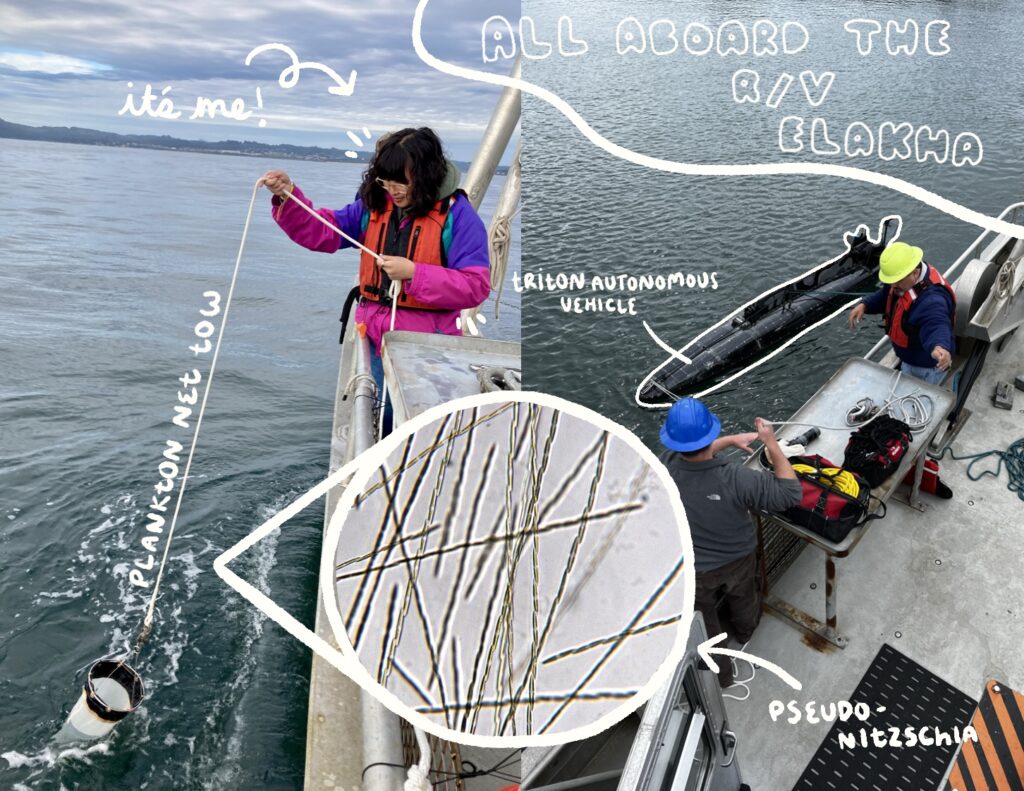Hello everyone! My name is Alex Ang, and this is the first of many blog posts detailing my experience as a 2022 Oregon Sea Grant Summer Scholar. After graduating from Macalester College in May, I packed my bags and flew out to the west coast for the first time in my entire life. For the next ten weeks in Newport, Oregon, I’ll be working with the Newport Hydrographic Line Team at NOAA Fisheries and Oregon State University. I will be examining harmful algal blooms on the Oregon coast, specifically looking at the diatom, Pseudo-nitzschia. Though I’ve worked with harmful algal blooms (HABs) many times before, this is my first time working with this species and bloom dynamics on this side of the world. My experience with HABs was limited to laboratory growth experiments, never looking at the organisms in their natural environment. I will also be dipping my toes into studying the toxin they produce, domoic acid. I will use both field surveys and processing water samples to inform my research about patterns in toxin production when different environmental drivers are present.
I arrived on campus at the perfect time, just as my team was getting ready to test drive an autonomous sailing vehicle, known as the Triton, capable of collecting offshore water samples for HABs. In a huge collaborative effort between the University of Washington, Oregon State University, the Northwest Association of Networked Ocean Observing SystemsNOAA Northwest Fisheries Science Center, and the Olympic Region Harmful Algal Bloom Partnership they hope to significantly enhance HAB forecast accuracy and sampling capability. Being on the water was a lot of fun, as I rarely got to do any type of field work in my previous research experiences. I learned that when out in the field, I have to be prepared for anything, since the weather can be unpredictable and research plans often change. Though not every week will look like this (testing out an autonomous vehicle!), it was amazing to have an opportunity to see a sampling vehicle in action.

When I’m not on a boat, my days will consist of processing a backlog of water samples from 2021 with enzyme-linked immunoassays (ELISAs) to detect particulate domoic acid (pDA) as well as extracting chlorophyll from preserved samples. I will look at these data in tandem with conductivity, temperature, and depth profiles to examine patterns in toxin production and Pseudo-nitzschia abundance. Through helping the Newport Hydrographic Line Team process this backlog of data, I am contributing to a broader understanding of PN toxin production that could help inform recreational/commercial shellfish management.
While the research is a huge part of my project this summer, I am also invested in working on adding a science communication aspect to it. At the end of the summer, I will produce an exhibit in the Hatfield Marine Science Visitor Center about the Newport Hydrographic Line and its research efforts. With my display, I hope to increase awareness of the Line and get the public interested in the various research that is being completed. Leveraging my experience with community outreach, I will also contact local boat tours about incorporating wording about the NHL. My project’s interdisciplinary approach aligns with Oregon Sea Grant’s mission of promoting discovery, understanding and resilience to Oregon’s communities and ecosystems. As a STEM and Humanities major myself, it has been quite the journey to bridge the gap between my two disciplines.
Next week, I’ll be jumping into more lab and field work related to my project. I will begin to uncover the patterns of pDA production and drivers of Pseudo-nitzschia blooms on the Oregon coast. Stay tuned and follow me through my summer journey!


So excited to see your exhibit at the visitors center! Great post! :)